Strategic Management CW 2: McDonald's Strategy Analysis and Plan
VerifiedAdded on 2019/09/30
|17
|4327
|161
Report
AI Summary
This report provides a strategic analysis of McDonald's, covering business-level and corporate-level strategies, environmental factors, and resource analysis. It examines cost leadership and differentiation strategies, along with the use of SWOT and PESTLE analyses. The report develops a strategic plan for McDonald's, including a mission statement focused on improved service and social responsibility, along with strategic directions, objectives, and Key Performance Indicators (KPIs). It also addresses resource implications and a strategy implementation plan, including communication methods and monitoring systems. The report emphasizes the importance of adapting to market trends and maintaining competitive advantages through both cost-effective and differentiated approaches, providing a comprehensive overview of strategic management principles applied to a real-world business case.
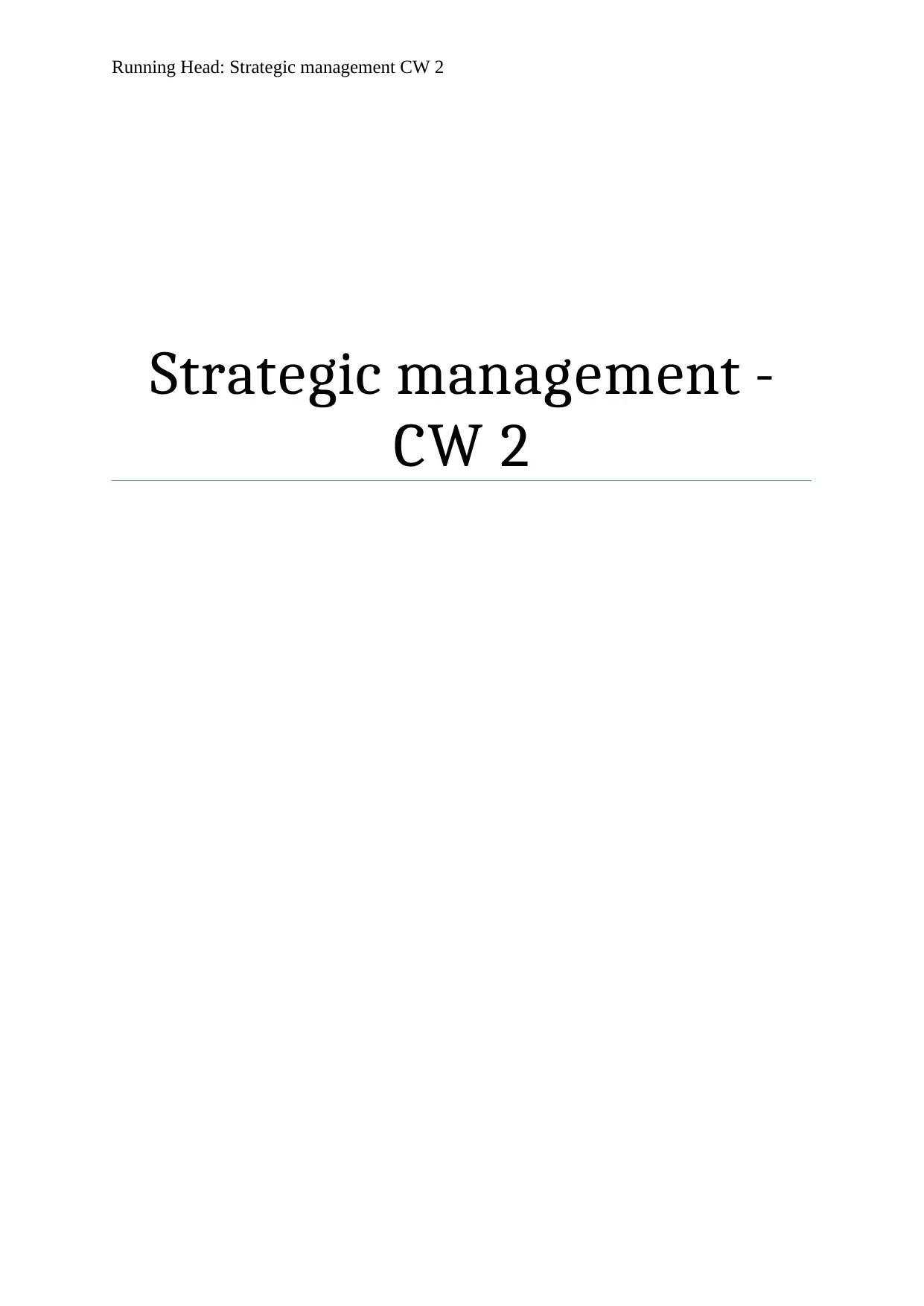
Running Head: Strategic management CW 2
Strategic management -
CW 2
Strategic management -
CW 2
Paraphrase This Document
Need a fresh take? Get an instant paraphrase of this document with our AI Paraphraser
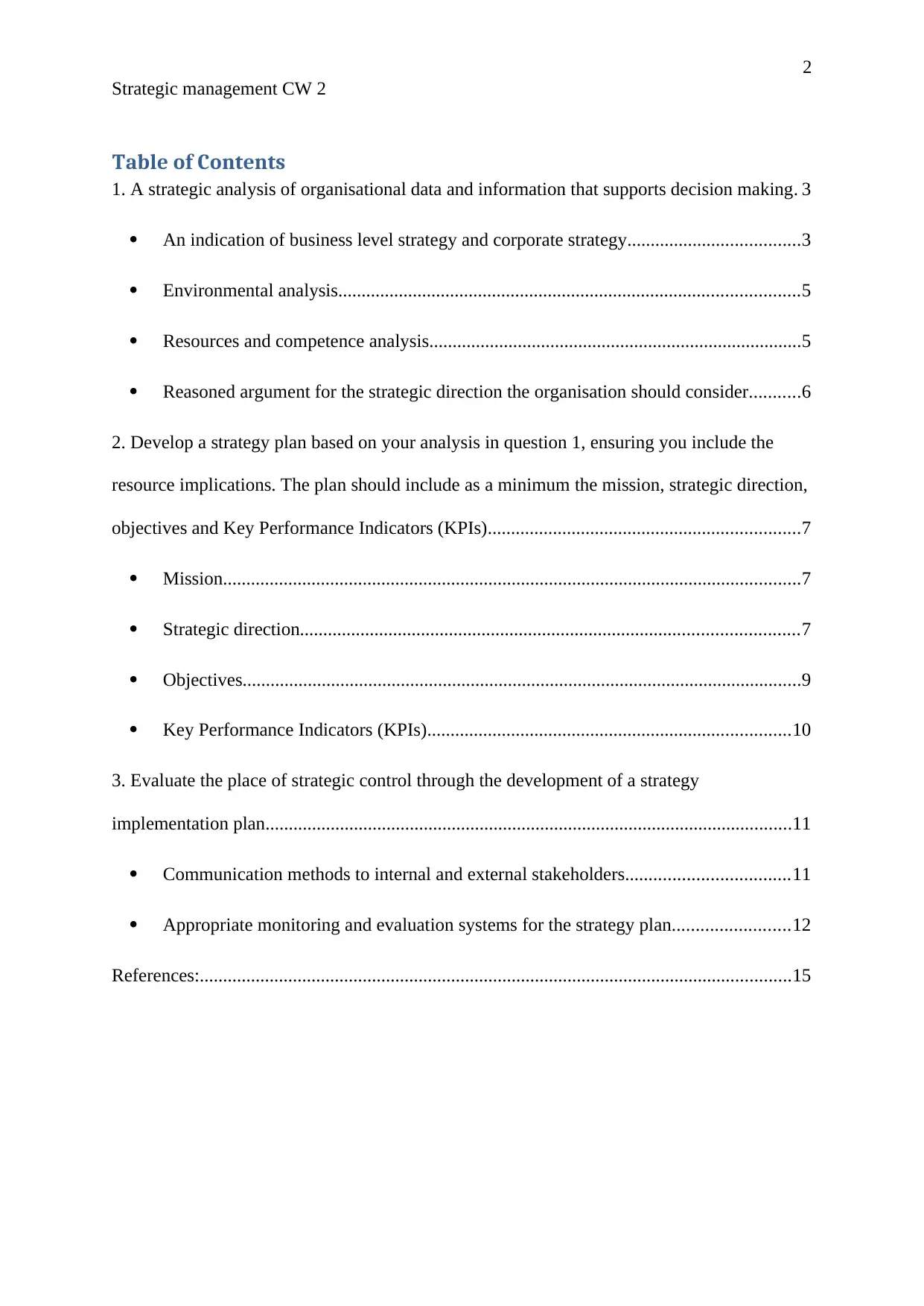
2
Strategic management CW 2
Table of Contents
1. A strategic analysis of organisational data and information that supports decision making. 3
An indication of business level strategy and corporate strategy.....................................3
Environmental analysis...................................................................................................5
Resources and competence analysis................................................................................5
Reasoned argument for the strategic direction the organisation should consider...........6
2. Develop a strategy plan based on your analysis in question 1, ensuring you include the
resource implications. The plan should include as a minimum the mission, strategic direction,
objectives and Key Performance Indicators (KPIs)...................................................................7
Mission............................................................................................................................7
Strategic direction...........................................................................................................7
Objectives........................................................................................................................9
Key Performance Indicators (KPIs)..............................................................................10
3. Evaluate the place of strategic control through the development of a strategy
implementation plan.................................................................................................................11
Communication methods to internal and external stakeholders...................................11
Appropriate monitoring and evaluation systems for the strategy plan.........................12
References:...............................................................................................................................15
Strategic management CW 2
Table of Contents
1. A strategic analysis of organisational data and information that supports decision making. 3
An indication of business level strategy and corporate strategy.....................................3
Environmental analysis...................................................................................................5
Resources and competence analysis................................................................................5
Reasoned argument for the strategic direction the organisation should consider...........6
2. Develop a strategy plan based on your analysis in question 1, ensuring you include the
resource implications. The plan should include as a minimum the mission, strategic direction,
objectives and Key Performance Indicators (KPIs)...................................................................7
Mission............................................................................................................................7
Strategic direction...........................................................................................................7
Objectives........................................................................................................................9
Key Performance Indicators (KPIs)..............................................................................10
3. Evaluate the place of strategic control through the development of a strategy
implementation plan.................................................................................................................11
Communication methods to internal and external stakeholders...................................11
Appropriate monitoring and evaluation systems for the strategy plan.........................12
References:...............................................................................................................................15
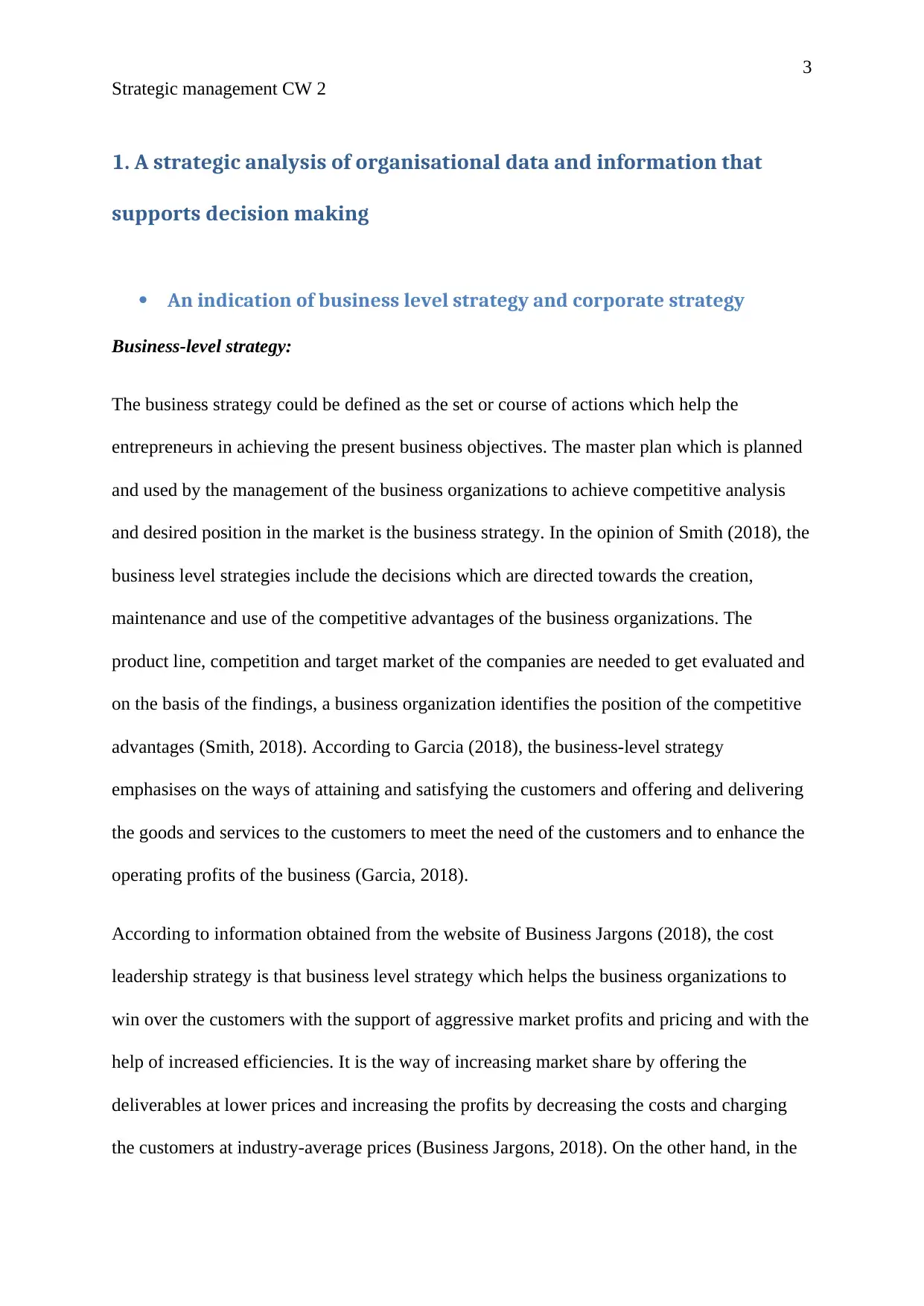
3
Strategic management CW 2
1. A strategic analysis of organisational data and information that
supports decision making
An indication of business level strategy and corporate strategy
Business-level strategy:
The business strategy could be defined as the set or course of actions which help the
entrepreneurs in achieving the present business objectives. The master plan which is planned
and used by the management of the business organizations to achieve competitive analysis
and desired position in the market is the business strategy. In the opinion of Smith (2018), the
business level strategies include the decisions which are directed towards the creation,
maintenance and use of the competitive advantages of the business organizations. The
product line, competition and target market of the companies are needed to get evaluated and
on the basis of the findings, a business organization identifies the position of the competitive
advantages (Smith, 2018). According to Garcia (2018), the business-level strategy
emphasises on the ways of attaining and satisfying the customers and offering and delivering
the goods and services to the customers to meet the need of the customers and to enhance the
operating profits of the business (Garcia, 2018).
According to information obtained from the website of Business Jargons (2018), the cost
leadership strategy is that business level strategy which helps the business organizations to
win over the customers with the support of aggressive market profits and pricing and with the
help of increased efficiencies. It is the way of increasing market share by offering the
deliverables at lower prices and increasing the profits by decreasing the costs and charging
the customers at industry-average prices (Business Jargons, 2018). On the other hand, in the
Strategic management CW 2
1. A strategic analysis of organisational data and information that
supports decision making
An indication of business level strategy and corporate strategy
Business-level strategy:
The business strategy could be defined as the set or course of actions which help the
entrepreneurs in achieving the present business objectives. The master plan which is planned
and used by the management of the business organizations to achieve competitive analysis
and desired position in the market is the business strategy. In the opinion of Smith (2018), the
business level strategies include the decisions which are directed towards the creation,
maintenance and use of the competitive advantages of the business organizations. The
product line, competition and target market of the companies are needed to get evaluated and
on the basis of the findings, a business organization identifies the position of the competitive
advantages (Smith, 2018). According to Garcia (2018), the business-level strategy
emphasises on the ways of attaining and satisfying the customers and offering and delivering
the goods and services to the customers to meet the need of the customers and to enhance the
operating profits of the business (Garcia, 2018).
According to information obtained from the website of Business Jargons (2018), the cost
leadership strategy is that business level strategy which helps the business organizations to
win over the customers with the support of aggressive market profits and pricing and with the
help of increased efficiencies. It is the way of increasing market share by offering the
deliverables at lower prices and increasing the profits by decreasing the costs and charging
the customers at industry-average prices (Business Jargons, 2018). On the other hand, in the
⊘ This is a preview!⊘
Do you want full access?
Subscribe today to unlock all pages.

Trusted by 1+ million students worldwide
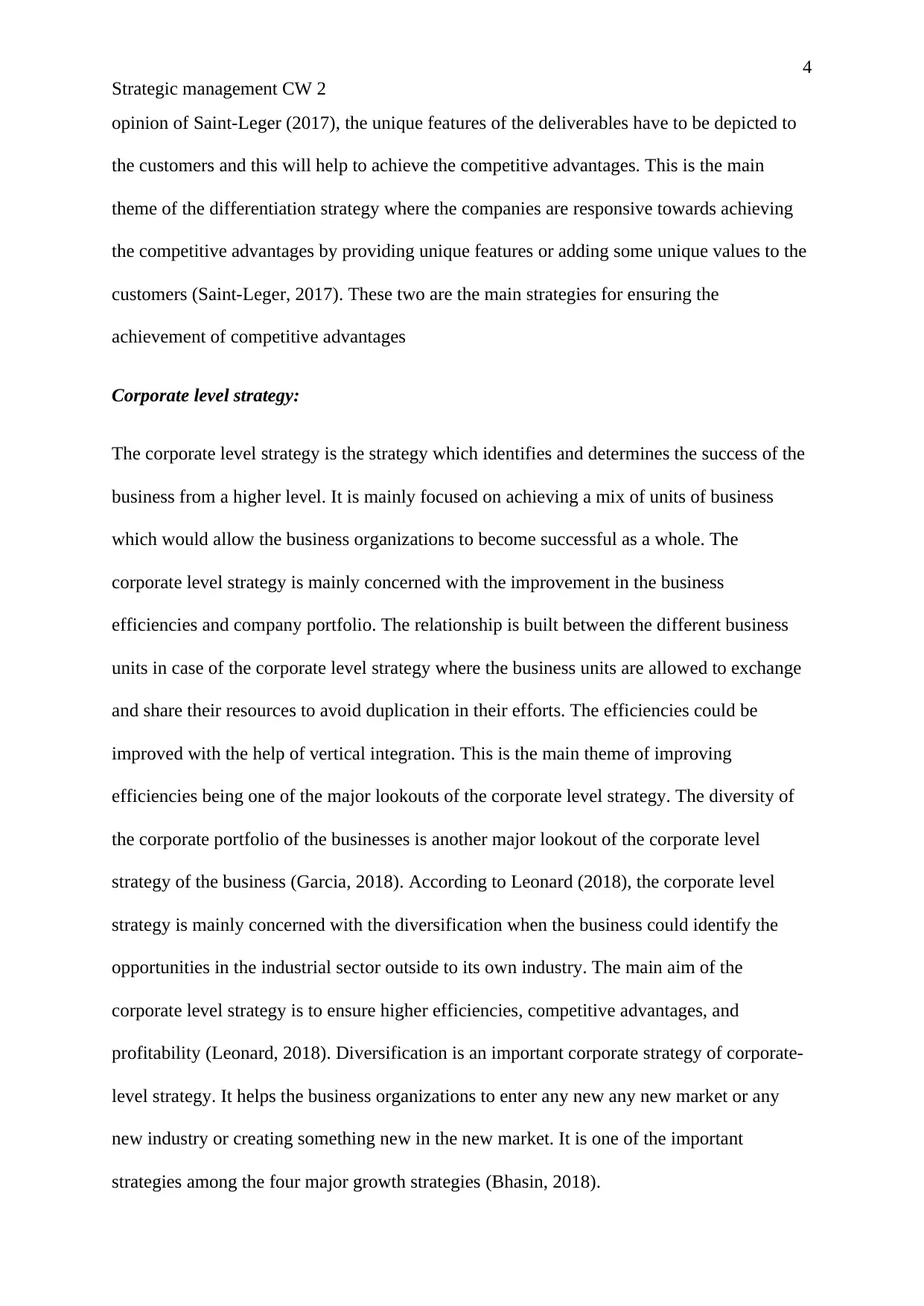
4
Strategic management CW 2
opinion of Saint-Leger (2017), the unique features of the deliverables have to be depicted to
the customers and this will help to achieve the competitive advantages. This is the main
theme of the differentiation strategy where the companies are responsive towards achieving
the competitive advantages by providing unique features or adding some unique values to the
customers (Saint-Leger, 2017). These two are the main strategies for ensuring the
achievement of competitive advantages
Corporate level strategy:
The corporate level strategy is the strategy which identifies and determines the success of the
business from a higher level. It is mainly focused on achieving a mix of units of business
which would allow the business organizations to become successful as a whole. The
corporate level strategy is mainly concerned with the improvement in the business
efficiencies and company portfolio. The relationship is built between the different business
units in case of the corporate level strategy where the business units are allowed to exchange
and share their resources to avoid duplication in their efforts. The efficiencies could be
improved with the help of vertical integration. This is the main theme of improving
efficiencies being one of the major lookouts of the corporate level strategy. The diversity of
the corporate portfolio of the businesses is another major lookout of the corporate level
strategy of the business (Garcia, 2018). According to Leonard (2018), the corporate level
strategy is mainly concerned with the diversification when the business could identify the
opportunities in the industrial sector outside to its own industry. The main aim of the
corporate level strategy is to ensure higher efficiencies, competitive advantages, and
profitability (Leonard, 2018). Diversification is an important corporate strategy of corporate-
level strategy. It helps the business organizations to enter any new any new market or any
new industry or creating something new in the new market. It is one of the important
strategies among the four major growth strategies (Bhasin, 2018).
Strategic management CW 2
opinion of Saint-Leger (2017), the unique features of the deliverables have to be depicted to
the customers and this will help to achieve the competitive advantages. This is the main
theme of the differentiation strategy where the companies are responsive towards achieving
the competitive advantages by providing unique features or adding some unique values to the
customers (Saint-Leger, 2017). These two are the main strategies for ensuring the
achievement of competitive advantages
Corporate level strategy:
The corporate level strategy is the strategy which identifies and determines the success of the
business from a higher level. It is mainly focused on achieving a mix of units of business
which would allow the business organizations to become successful as a whole. The
corporate level strategy is mainly concerned with the improvement in the business
efficiencies and company portfolio. The relationship is built between the different business
units in case of the corporate level strategy where the business units are allowed to exchange
and share their resources to avoid duplication in their efforts. The efficiencies could be
improved with the help of vertical integration. This is the main theme of improving
efficiencies being one of the major lookouts of the corporate level strategy. The diversity of
the corporate portfolio of the businesses is another major lookout of the corporate level
strategy of the business (Garcia, 2018). According to Leonard (2018), the corporate level
strategy is mainly concerned with the diversification when the business could identify the
opportunities in the industrial sector outside to its own industry. The main aim of the
corporate level strategy is to ensure higher efficiencies, competitive advantages, and
profitability (Leonard, 2018). Diversification is an important corporate strategy of corporate-
level strategy. It helps the business organizations to enter any new any new market or any
new industry or creating something new in the new market. It is one of the important
strategies among the four major growth strategies (Bhasin, 2018).
Paraphrase This Document
Need a fresh take? Get an instant paraphrase of this document with our AI Paraphraser
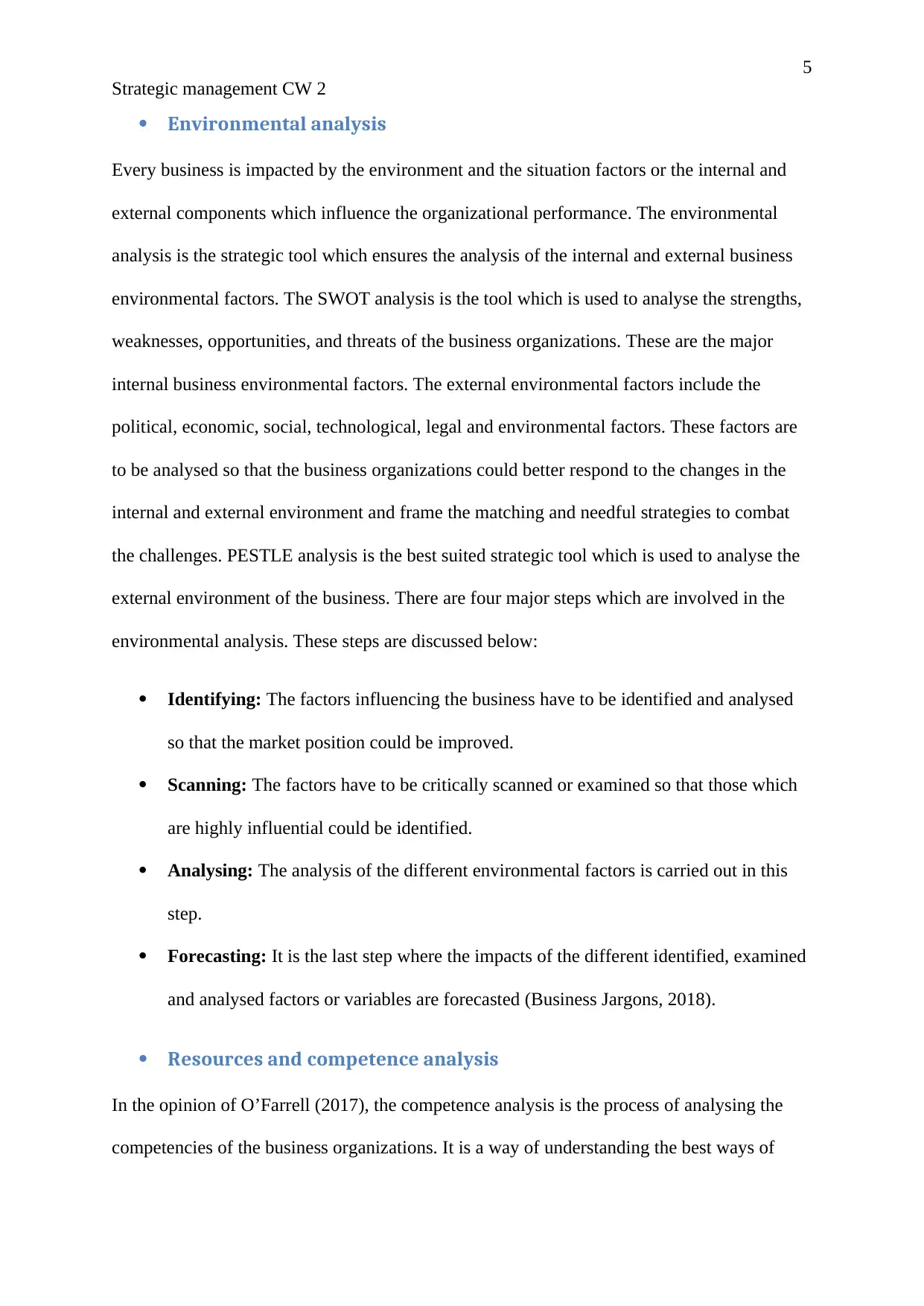
5
Strategic management CW 2
Environmental analysis
Every business is impacted by the environment and the situation factors or the internal and
external components which influence the organizational performance. The environmental
analysis is the strategic tool which ensures the analysis of the internal and external business
environmental factors. The SWOT analysis is the tool which is used to analyse the strengths,
weaknesses, opportunities, and threats of the business organizations. These are the major
internal business environmental factors. The external environmental factors include the
political, economic, social, technological, legal and environmental factors. These factors are
to be analysed so that the business organizations could better respond to the changes in the
internal and external environment and frame the matching and needful strategies to combat
the challenges. PESTLE analysis is the best suited strategic tool which is used to analyse the
external environment of the business. There are four major steps which are involved in the
environmental analysis. These steps are discussed below:
Identifying: The factors influencing the business have to be identified and analysed
so that the market position could be improved.
Scanning: The factors have to be critically scanned or examined so that those which
are highly influential could be identified.
Analysing: The analysis of the different environmental factors is carried out in this
step.
Forecasting: It is the last step where the impacts of the different identified, examined
and analysed factors or variables are forecasted (Business Jargons, 2018).
Resources and competence analysis
In the opinion of O’Farrell (2017), the competence analysis is the process of analysing the
competencies of the business organizations. It is a way of understanding the best ways of
Strategic management CW 2
Environmental analysis
Every business is impacted by the environment and the situation factors or the internal and
external components which influence the organizational performance. The environmental
analysis is the strategic tool which ensures the analysis of the internal and external business
environmental factors. The SWOT analysis is the tool which is used to analyse the strengths,
weaknesses, opportunities, and threats of the business organizations. These are the major
internal business environmental factors. The external environmental factors include the
political, economic, social, technological, legal and environmental factors. These factors are
to be analysed so that the business organizations could better respond to the changes in the
internal and external environment and frame the matching and needful strategies to combat
the challenges. PESTLE analysis is the best suited strategic tool which is used to analyse the
external environment of the business. There are four major steps which are involved in the
environmental analysis. These steps are discussed below:
Identifying: The factors influencing the business have to be identified and analysed
so that the market position could be improved.
Scanning: The factors have to be critically scanned or examined so that those which
are highly influential could be identified.
Analysing: The analysis of the different environmental factors is carried out in this
step.
Forecasting: It is the last step where the impacts of the different identified, examined
and analysed factors or variables are forecasted (Business Jargons, 2018).
Resources and competence analysis
In the opinion of O’Farrell (2017), the competence analysis is the process of analysing the
competencies of the business organizations. It is a way of understanding the best ways of
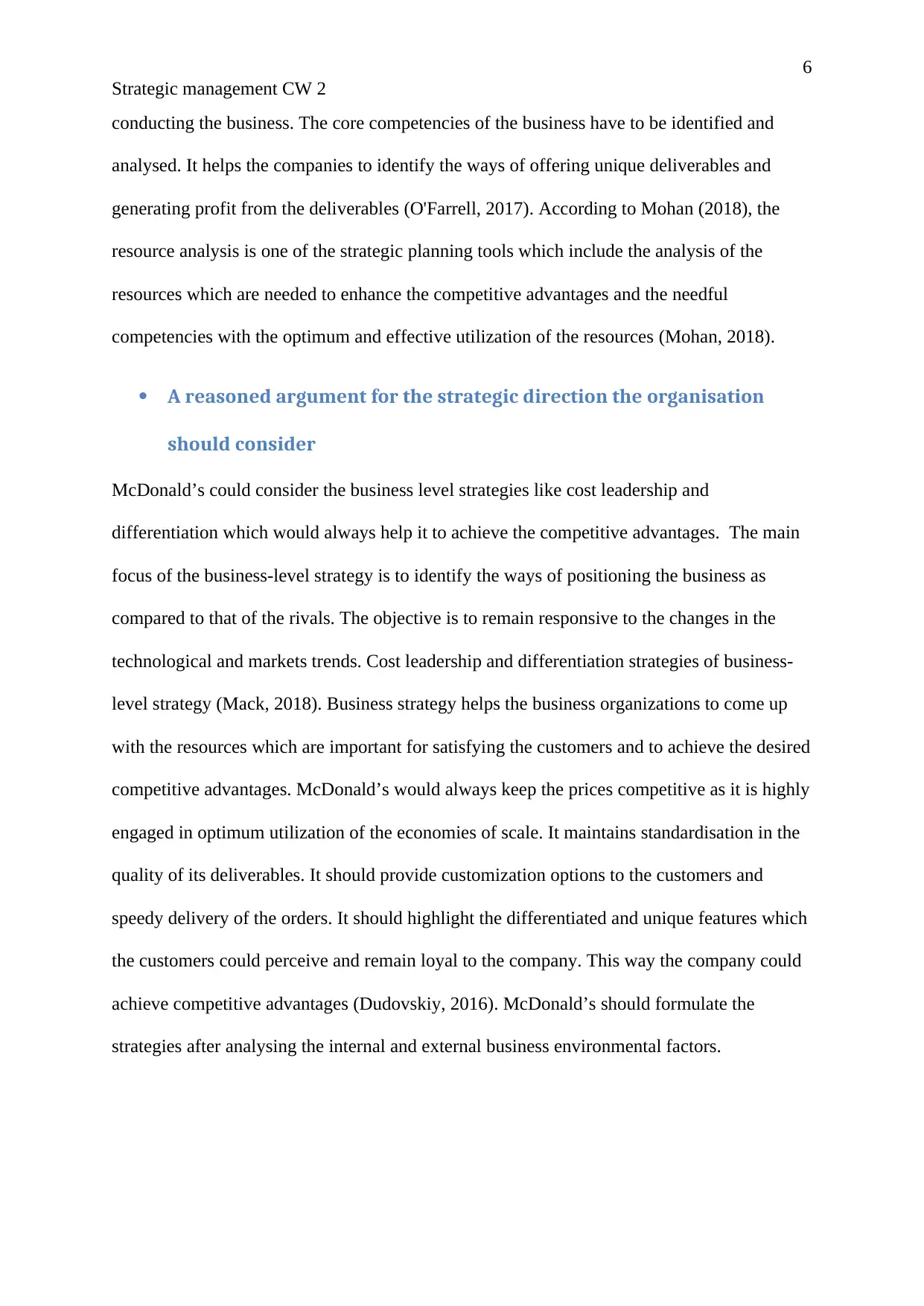
6
Strategic management CW 2
conducting the business. The core competencies of the business have to be identified and
analysed. It helps the companies to identify the ways of offering unique deliverables and
generating profit from the deliverables (O'Farrell, 2017). According to Mohan (2018), the
resource analysis is one of the strategic planning tools which include the analysis of the
resources which are needed to enhance the competitive advantages and the needful
competencies with the optimum and effective utilization of the resources (Mohan, 2018).
A reasoned argument for the strategic direction the organisation
should consider
McDonald’s could consider the business level strategies like cost leadership and
differentiation which would always help it to achieve the competitive advantages. The main
focus of the business-level strategy is to identify the ways of positioning the business as
compared to that of the rivals. The objective is to remain responsive to the changes in the
technological and markets trends. Cost leadership and differentiation strategies of business-
level strategy (Mack, 2018). Business strategy helps the business organizations to come up
with the resources which are important for satisfying the customers and to achieve the desired
competitive advantages. McDonald’s would always keep the prices competitive as it is highly
engaged in optimum utilization of the economies of scale. It maintains standardisation in the
quality of its deliverables. It should provide customization options to the customers and
speedy delivery of the orders. It should highlight the differentiated and unique features which
the customers could perceive and remain loyal to the company. This way the company could
achieve competitive advantages (Dudovskiy, 2016). McDonald’s should formulate the
strategies after analysing the internal and external business environmental factors.
Strategic management CW 2
conducting the business. The core competencies of the business have to be identified and
analysed. It helps the companies to identify the ways of offering unique deliverables and
generating profit from the deliverables (O'Farrell, 2017). According to Mohan (2018), the
resource analysis is one of the strategic planning tools which include the analysis of the
resources which are needed to enhance the competitive advantages and the needful
competencies with the optimum and effective utilization of the resources (Mohan, 2018).
A reasoned argument for the strategic direction the organisation
should consider
McDonald’s could consider the business level strategies like cost leadership and
differentiation which would always help it to achieve the competitive advantages. The main
focus of the business-level strategy is to identify the ways of positioning the business as
compared to that of the rivals. The objective is to remain responsive to the changes in the
technological and markets trends. Cost leadership and differentiation strategies of business-
level strategy (Mack, 2018). Business strategy helps the business organizations to come up
with the resources which are important for satisfying the customers and to achieve the desired
competitive advantages. McDonald’s would always keep the prices competitive as it is highly
engaged in optimum utilization of the economies of scale. It maintains standardisation in the
quality of its deliverables. It should provide customization options to the customers and
speedy delivery of the orders. It should highlight the differentiated and unique features which
the customers could perceive and remain loyal to the company. This way the company could
achieve competitive advantages (Dudovskiy, 2016). McDonald’s should formulate the
strategies after analysing the internal and external business environmental factors.
⊘ This is a preview!⊘
Do you want full access?
Subscribe today to unlock all pages.

Trusted by 1+ million students worldwide
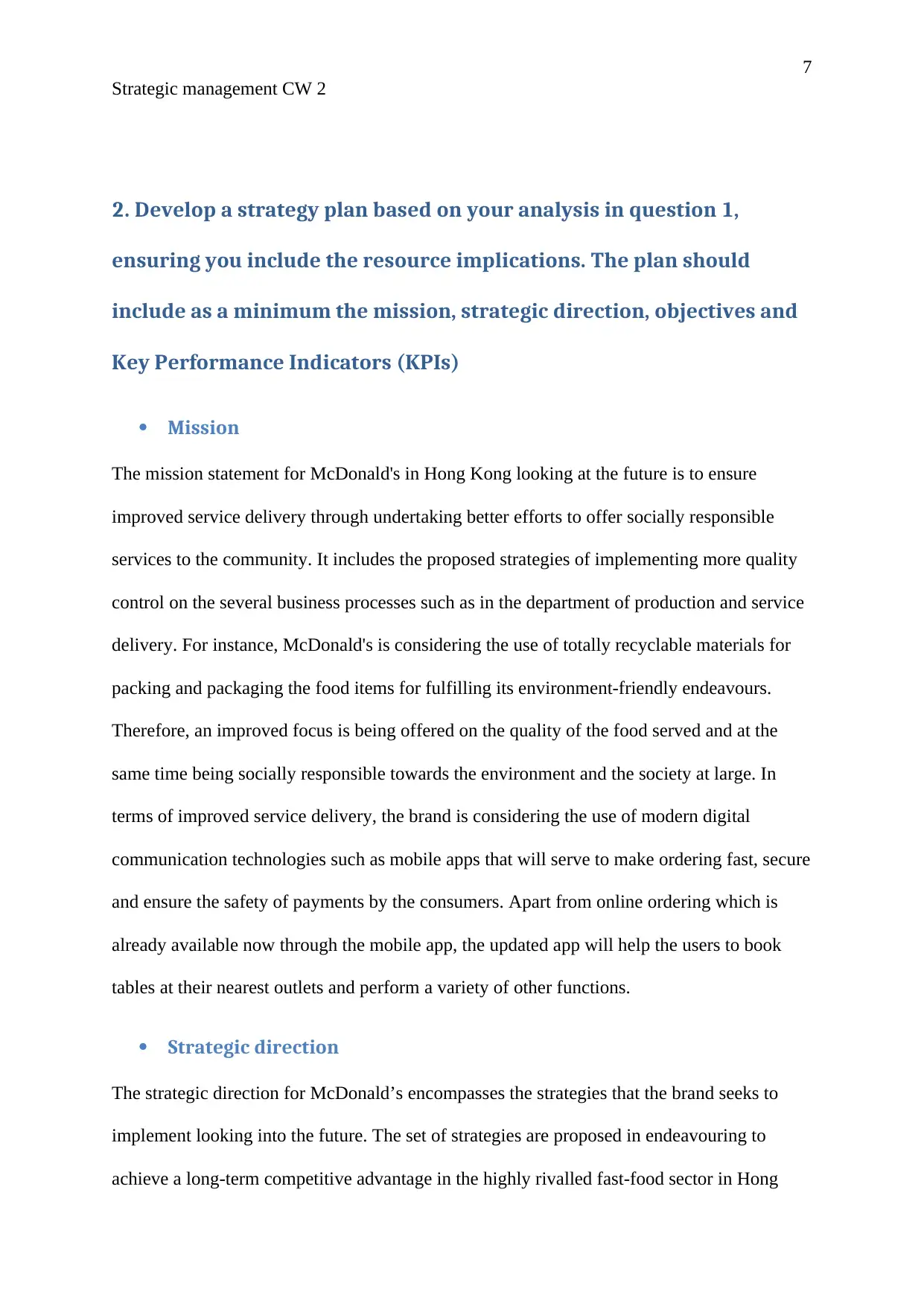
7
Strategic management CW 2
2. Develop a strategy plan based on your analysis in question 1,
ensuring you include the resource implications. The plan should
include as a minimum the mission, strategic direction, objectives and
Key Performance Indicators (KPIs)
Mission
The mission statement for McDonald's in Hong Kong looking at the future is to ensure
improved service delivery through undertaking better efforts to offer socially responsible
services to the community. It includes the proposed strategies of implementing more quality
control on the several business processes such as in the department of production and service
delivery. For instance, McDonald's is considering the use of totally recyclable materials for
packing and packaging the food items for fulfilling its environment-friendly endeavours.
Therefore, an improved focus is being offered on the quality of the food served and at the
same time being socially responsible towards the environment and the society at large. In
terms of improved service delivery, the brand is considering the use of modern digital
communication technologies such as mobile apps that will serve to make ordering fast, secure
and ensure the safety of payments by the consumers. Apart from online ordering which is
already available now through the mobile app, the updated app will help the users to book
tables at their nearest outlets and perform a variety of other functions.
Strategic direction
The strategic direction for McDonald’s encompasses the strategies that the brand seeks to
implement looking into the future. The set of strategies are proposed in endeavouring to
achieve a long-term competitive advantage in the highly rivalled fast-food sector in Hong
Strategic management CW 2
2. Develop a strategy plan based on your analysis in question 1,
ensuring you include the resource implications. The plan should
include as a minimum the mission, strategic direction, objectives and
Key Performance Indicators (KPIs)
Mission
The mission statement for McDonald's in Hong Kong looking at the future is to ensure
improved service delivery through undertaking better efforts to offer socially responsible
services to the community. It includes the proposed strategies of implementing more quality
control on the several business processes such as in the department of production and service
delivery. For instance, McDonald's is considering the use of totally recyclable materials for
packing and packaging the food items for fulfilling its environment-friendly endeavours.
Therefore, an improved focus is being offered on the quality of the food served and at the
same time being socially responsible towards the environment and the society at large. In
terms of improved service delivery, the brand is considering the use of modern digital
communication technologies such as mobile apps that will serve to make ordering fast, secure
and ensure the safety of payments by the consumers. Apart from online ordering which is
already available now through the mobile app, the updated app will help the users to book
tables at their nearest outlets and perform a variety of other functions.
Strategic direction
The strategic direction for McDonald’s encompasses the strategies that the brand seeks to
implement looking into the future. The set of strategies are proposed in endeavouring to
achieve a long-term competitive advantage in the highly rivalled fast-food sector in Hong
Paraphrase This Document
Need a fresh take? Get an instant paraphrase of this document with our AI Paraphraser
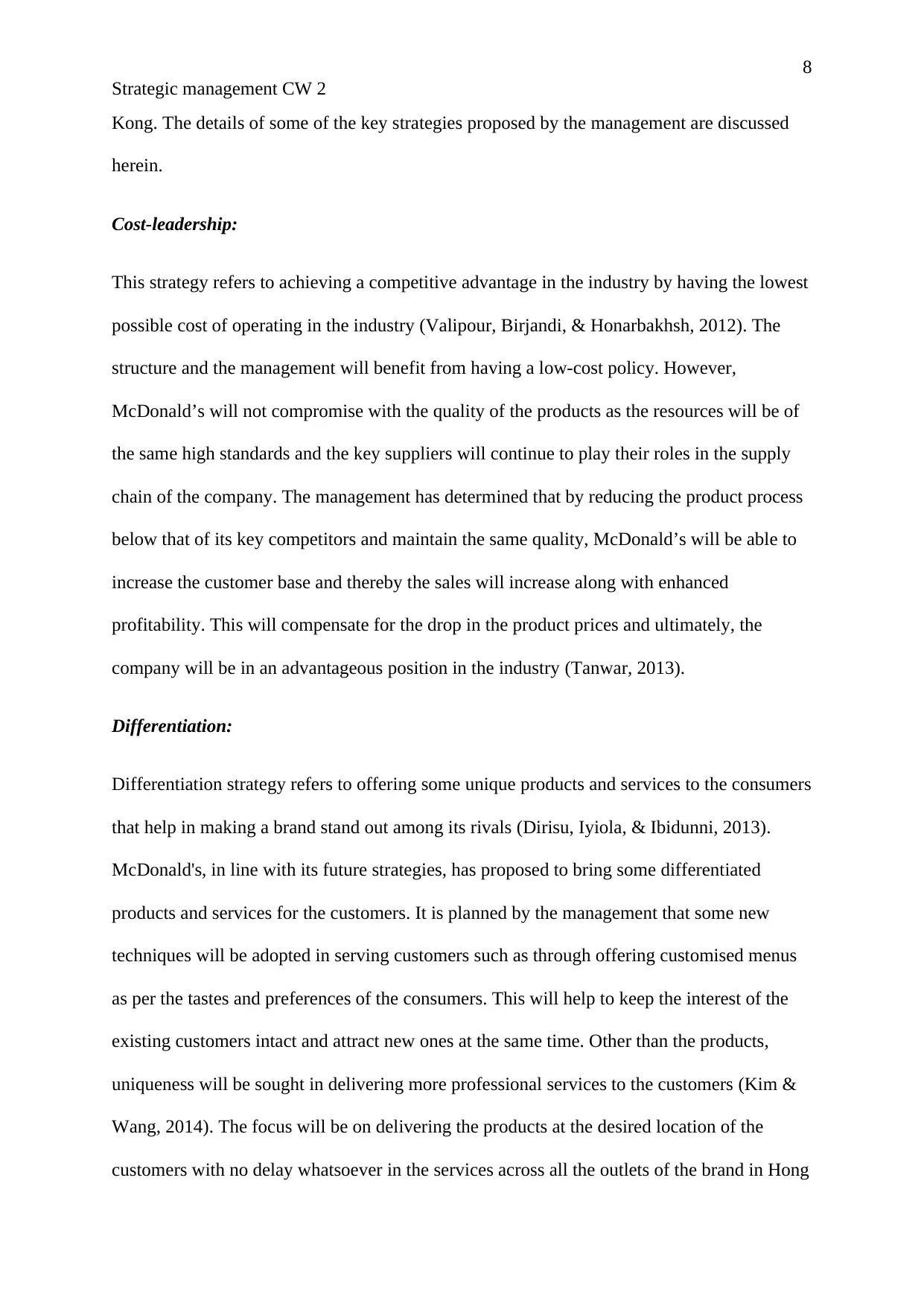
8
Strategic management CW 2
Kong. The details of some of the key strategies proposed by the management are discussed
herein.
Cost-leadership:
This strategy refers to achieving a competitive advantage in the industry by having the lowest
possible cost of operating in the industry (Valipour, Birjandi, & Honarbakhsh, 2012). The
structure and the management will benefit from having a low-cost policy. However,
McDonald’s will not compromise with the quality of the products as the resources will be of
the same high standards and the key suppliers will continue to play their roles in the supply
chain of the company. The management has determined that by reducing the product process
below that of its key competitors and maintain the same quality, McDonald’s will be able to
increase the customer base and thereby the sales will increase along with enhanced
profitability. This will compensate for the drop in the product prices and ultimately, the
company will be in an advantageous position in the industry (Tanwar, 2013).
Differentiation:
Differentiation strategy refers to offering some unique products and services to the consumers
that help in making a brand stand out among its rivals (Dirisu, Iyiola, & Ibidunni, 2013).
McDonald's, in line with its future strategies, has proposed to bring some differentiated
products and services for the customers. It is planned by the management that some new
techniques will be adopted in serving customers such as through offering customised menus
as per the tastes and preferences of the consumers. This will help to keep the interest of the
existing customers intact and attract new ones at the same time. Other than the products,
uniqueness will be sought in delivering more professional services to the customers (Kim &
Wang, 2014). The focus will be on delivering the products at the desired location of the
customers with no delay whatsoever in the services across all the outlets of the brand in Hong
Strategic management CW 2
Kong. The details of some of the key strategies proposed by the management are discussed
herein.
Cost-leadership:
This strategy refers to achieving a competitive advantage in the industry by having the lowest
possible cost of operating in the industry (Valipour, Birjandi, & Honarbakhsh, 2012). The
structure and the management will benefit from having a low-cost policy. However,
McDonald’s will not compromise with the quality of the products as the resources will be of
the same high standards and the key suppliers will continue to play their roles in the supply
chain of the company. The management has determined that by reducing the product process
below that of its key competitors and maintain the same quality, McDonald’s will be able to
increase the customer base and thereby the sales will increase along with enhanced
profitability. This will compensate for the drop in the product prices and ultimately, the
company will be in an advantageous position in the industry (Tanwar, 2013).
Differentiation:
Differentiation strategy refers to offering some unique products and services to the consumers
that help in making a brand stand out among its rivals (Dirisu, Iyiola, & Ibidunni, 2013).
McDonald's, in line with its future strategies, has proposed to bring some differentiated
products and services for the customers. It is planned by the management that some new
techniques will be adopted in serving customers such as through offering customised menus
as per the tastes and preferences of the consumers. This will help to keep the interest of the
existing customers intact and attract new ones at the same time. Other than the products,
uniqueness will be sought in delivering more professional services to the customers (Kim &
Wang, 2014). The focus will be on delivering the products at the desired location of the
customers with no delay whatsoever in the services across all the outlets of the brand in Hong
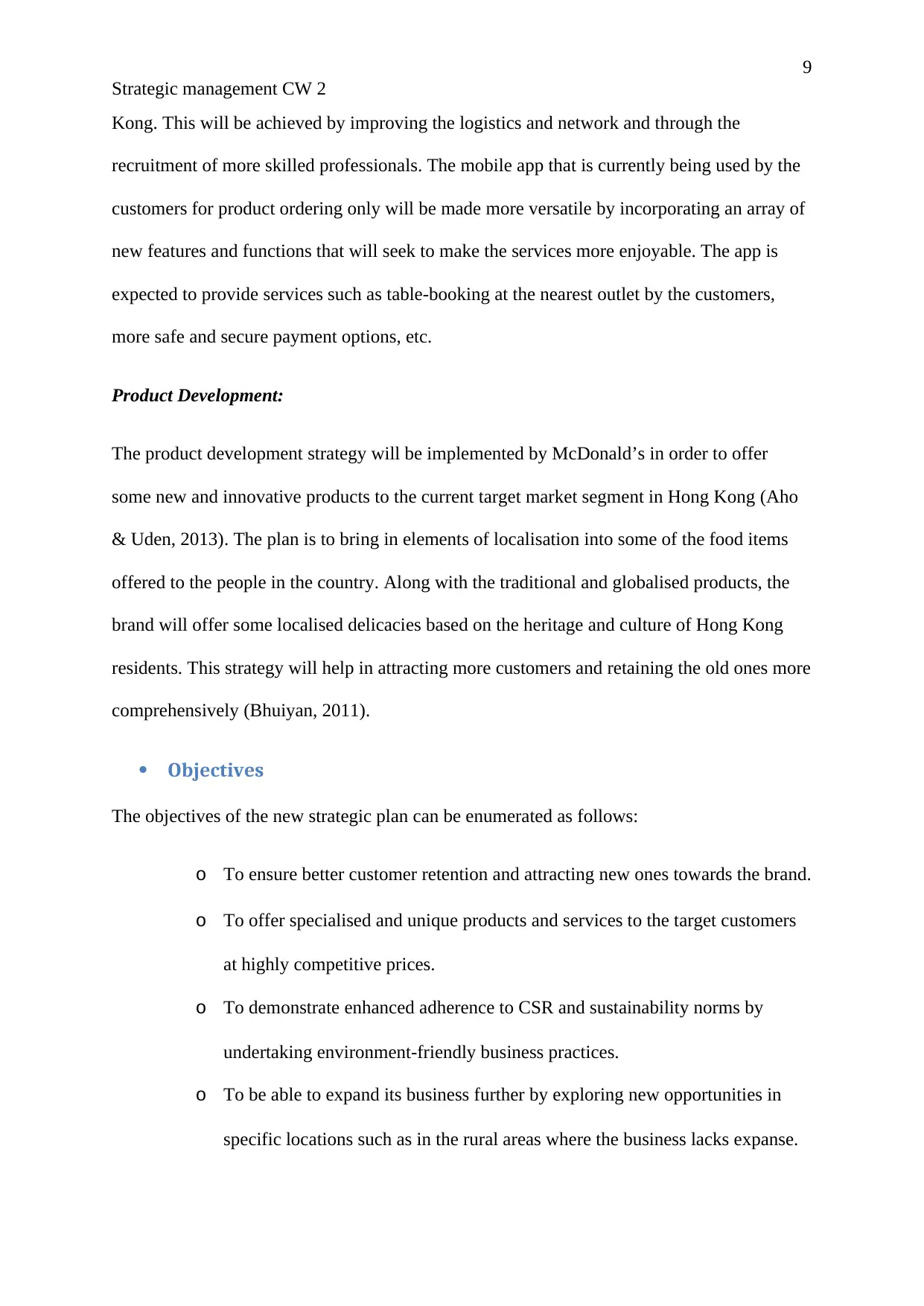
9
Strategic management CW 2
Kong. This will be achieved by improving the logistics and network and through the
recruitment of more skilled professionals. The mobile app that is currently being used by the
customers for product ordering only will be made more versatile by incorporating an array of
new features and functions that will seek to make the services more enjoyable. The app is
expected to provide services such as table-booking at the nearest outlet by the customers,
more safe and secure payment options, etc.
Product Development:
The product development strategy will be implemented by McDonald’s in order to offer
some new and innovative products to the current target market segment in Hong Kong (Aho
& Uden, 2013). The plan is to bring in elements of localisation into some of the food items
offered to the people in the country. Along with the traditional and globalised products, the
brand will offer some localised delicacies based on the heritage and culture of Hong Kong
residents. This strategy will help in attracting more customers and retaining the old ones more
comprehensively (Bhuiyan, 2011).
Objectives
The objectives of the new strategic plan can be enumerated as follows:
o To ensure better customer retention and attracting new ones towards the brand.
o To offer specialised and unique products and services to the target customers
at highly competitive prices.
o To demonstrate enhanced adherence to CSR and sustainability norms by
undertaking environment-friendly business practices.
o To be able to expand its business further by exploring new opportunities in
specific locations such as in the rural areas where the business lacks expanse.
Strategic management CW 2
Kong. This will be achieved by improving the logistics and network and through the
recruitment of more skilled professionals. The mobile app that is currently being used by the
customers for product ordering only will be made more versatile by incorporating an array of
new features and functions that will seek to make the services more enjoyable. The app is
expected to provide services such as table-booking at the nearest outlet by the customers,
more safe and secure payment options, etc.
Product Development:
The product development strategy will be implemented by McDonald’s in order to offer
some new and innovative products to the current target market segment in Hong Kong (Aho
& Uden, 2013). The plan is to bring in elements of localisation into some of the food items
offered to the people in the country. Along with the traditional and globalised products, the
brand will offer some localised delicacies based on the heritage and culture of Hong Kong
residents. This strategy will help in attracting more customers and retaining the old ones more
comprehensively (Bhuiyan, 2011).
Objectives
The objectives of the new strategic plan can be enumerated as follows:
o To ensure better customer retention and attracting new ones towards the brand.
o To offer specialised and unique products and services to the target customers
at highly competitive prices.
o To demonstrate enhanced adherence to CSR and sustainability norms by
undertaking environment-friendly business practices.
o To be able to expand its business further by exploring new opportunities in
specific locations such as in the rural areas where the business lacks expanse.
⊘ This is a preview!⊘
Do you want full access?
Subscribe today to unlock all pages.

Trusted by 1+ million students worldwide
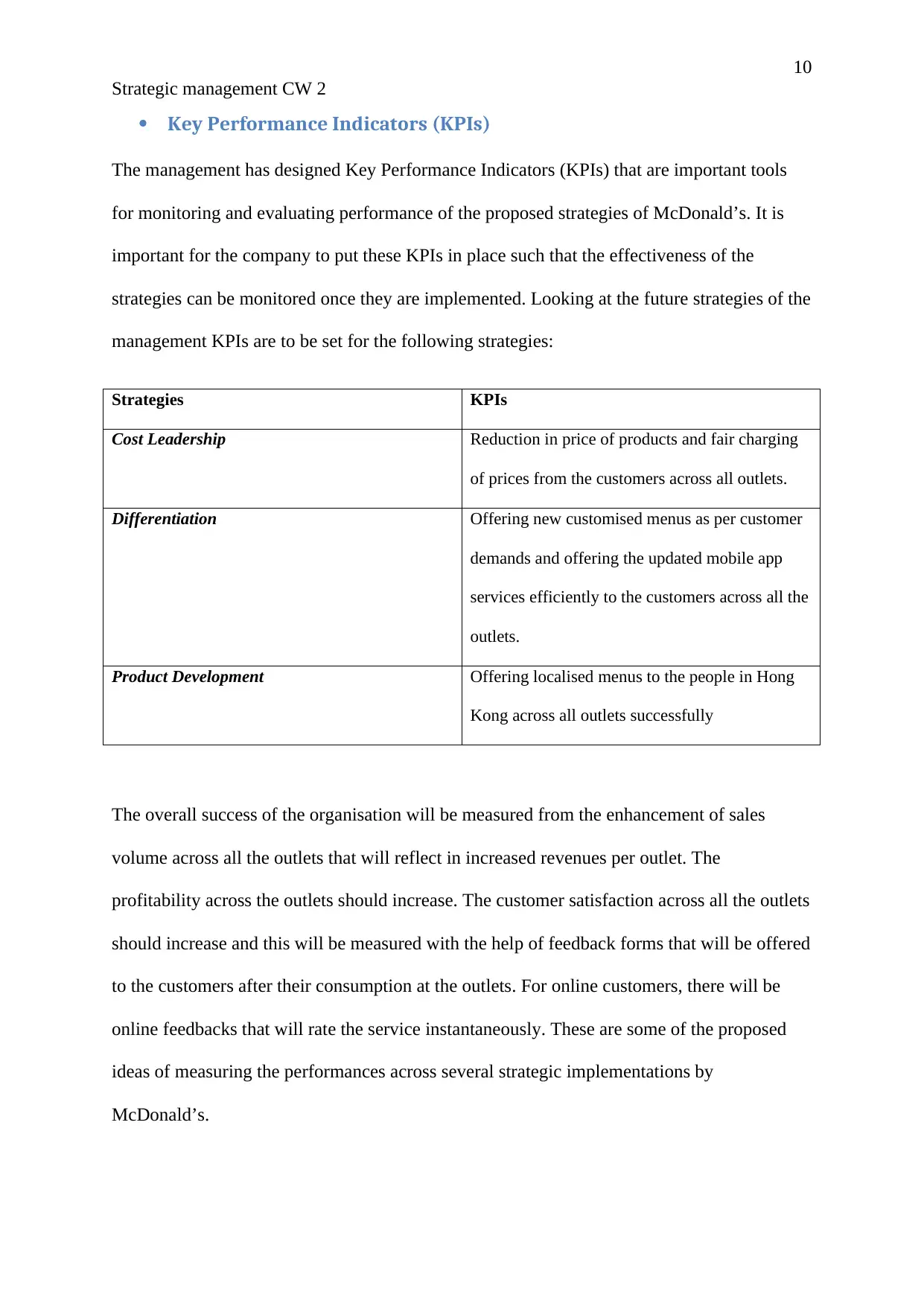
10
Strategic management CW 2
Key Performance Indicators (KPIs)
The management has designed Key Performance Indicators (KPIs) that are important tools
for monitoring and evaluating performance of the proposed strategies of McDonald’s. It is
important for the company to put these KPIs in place such that the effectiveness of the
strategies can be monitored once they are implemented. Looking at the future strategies of the
management KPIs are to be set for the following strategies:
Strategies KPIs
Cost Leadership Reduction in price of products and fair charging
of prices from the customers across all outlets.
Differentiation Offering new customised menus as per customer
demands and offering the updated mobile app
services efficiently to the customers across all the
outlets.
Product Development Offering localised menus to the people in Hong
Kong across all outlets successfully
The overall success of the organisation will be measured from the enhancement of sales
volume across all the outlets that will reflect in increased revenues per outlet. The
profitability across the outlets should increase. The customer satisfaction across all the outlets
should increase and this will be measured with the help of feedback forms that will be offered
to the customers after their consumption at the outlets. For online customers, there will be
online feedbacks that will rate the service instantaneously. These are some of the proposed
ideas of measuring the performances across several strategic implementations by
McDonald’s.
Strategic management CW 2
Key Performance Indicators (KPIs)
The management has designed Key Performance Indicators (KPIs) that are important tools
for monitoring and evaluating performance of the proposed strategies of McDonald’s. It is
important for the company to put these KPIs in place such that the effectiveness of the
strategies can be monitored once they are implemented. Looking at the future strategies of the
management KPIs are to be set for the following strategies:
Strategies KPIs
Cost Leadership Reduction in price of products and fair charging
of prices from the customers across all outlets.
Differentiation Offering new customised menus as per customer
demands and offering the updated mobile app
services efficiently to the customers across all the
outlets.
Product Development Offering localised menus to the people in Hong
Kong across all outlets successfully
The overall success of the organisation will be measured from the enhancement of sales
volume across all the outlets that will reflect in increased revenues per outlet. The
profitability across the outlets should increase. The customer satisfaction across all the outlets
should increase and this will be measured with the help of feedback forms that will be offered
to the customers after their consumption at the outlets. For online customers, there will be
online feedbacks that will rate the service instantaneously. These are some of the proposed
ideas of measuring the performances across several strategic implementations by
McDonald’s.
Paraphrase This Document
Need a fresh take? Get an instant paraphrase of this document with our AI Paraphraser
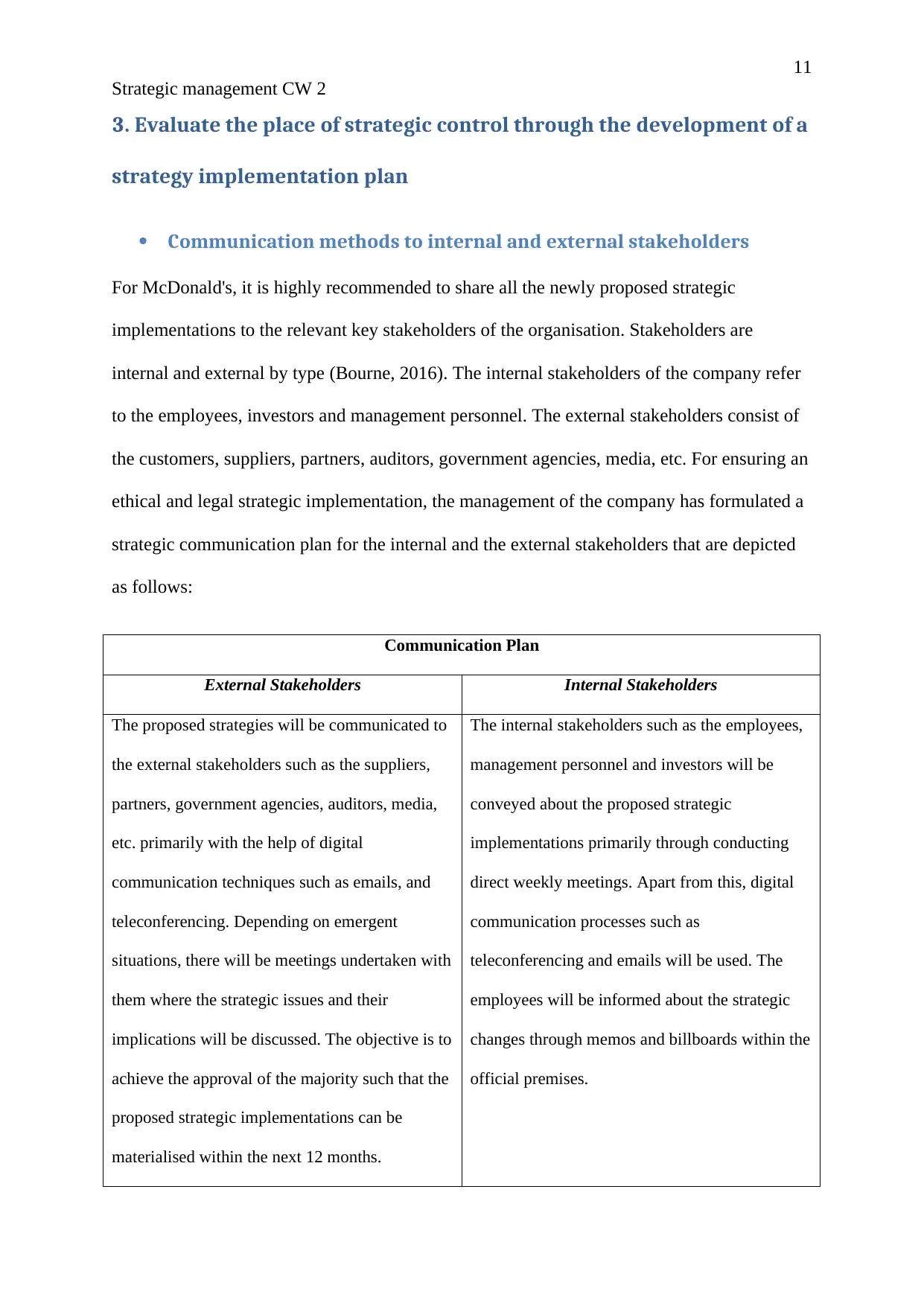
11
Strategic management CW 2
3. Evaluate the place of strategic control through the development of a
strategy implementation plan
Communication methods to internal and external stakeholders
For McDonald's, it is highly recommended to share all the newly proposed strategic
implementations to the relevant key stakeholders of the organisation. Stakeholders are
internal and external by type (Bourne, 2016). The internal stakeholders of the company refer
to the employees, investors and management personnel. The external stakeholders consist of
the customers, suppliers, partners, auditors, government agencies, media, etc. For ensuring an
ethical and legal strategic implementation, the management of the company has formulated a
strategic communication plan for the internal and the external stakeholders that are depicted
as follows:
Communication Plan
External Stakeholders Internal Stakeholders
The proposed strategies will be communicated to
the external stakeholders such as the suppliers,
partners, government agencies, auditors, media,
etc. primarily with the help of digital
communication techniques such as emails, and
teleconferencing. Depending on emergent
situations, there will be meetings undertaken with
them where the strategic issues and their
implications will be discussed. The objective is to
achieve the approval of the majority such that the
proposed strategic implementations can be
materialised within the next 12 months.
The internal stakeholders such as the employees,
management personnel and investors will be
conveyed about the proposed strategic
implementations primarily through conducting
direct weekly meetings. Apart from this, digital
communication processes such as
teleconferencing and emails will be used. The
employees will be informed about the strategic
changes through memos and billboards within the
official premises.
Strategic management CW 2
3. Evaluate the place of strategic control through the development of a
strategy implementation plan
Communication methods to internal and external stakeholders
For McDonald's, it is highly recommended to share all the newly proposed strategic
implementations to the relevant key stakeholders of the organisation. Stakeholders are
internal and external by type (Bourne, 2016). The internal stakeholders of the company refer
to the employees, investors and management personnel. The external stakeholders consist of
the customers, suppliers, partners, auditors, government agencies, media, etc. For ensuring an
ethical and legal strategic implementation, the management of the company has formulated a
strategic communication plan for the internal and the external stakeholders that are depicted
as follows:
Communication Plan
External Stakeholders Internal Stakeholders
The proposed strategies will be communicated to
the external stakeholders such as the suppliers,
partners, government agencies, auditors, media,
etc. primarily with the help of digital
communication techniques such as emails, and
teleconferencing. Depending on emergent
situations, there will be meetings undertaken with
them where the strategic issues and their
implications will be discussed. The objective is to
achieve the approval of the majority such that the
proposed strategic implementations can be
materialised within the next 12 months.
The internal stakeholders such as the employees,
management personnel and investors will be
conveyed about the proposed strategic
implementations primarily through conducting
direct weekly meetings. Apart from this, digital
communication processes such as
teleconferencing and emails will be used. The
employees will be informed about the strategic
changes through memos and billboards within the
official premises.
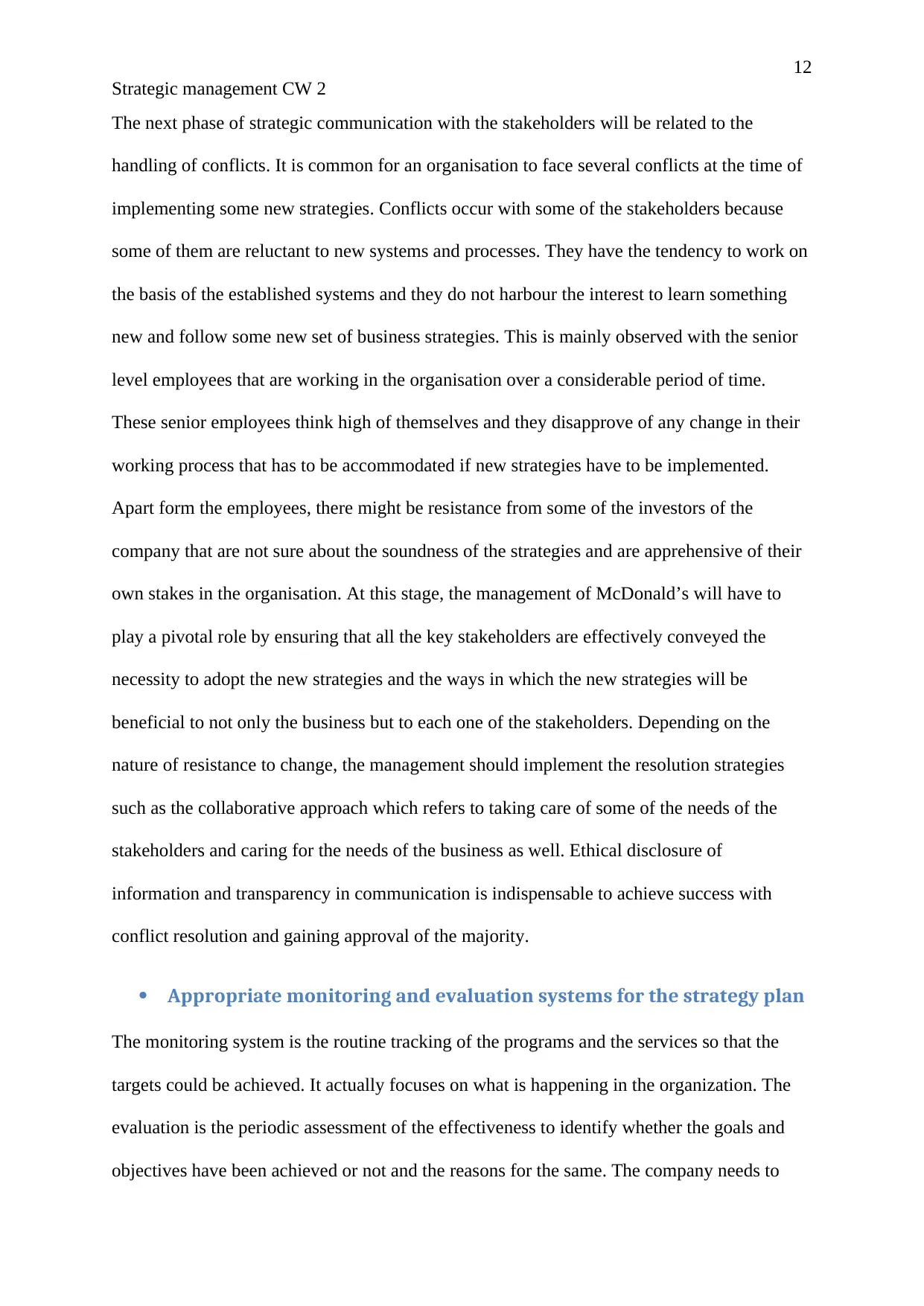
12
Strategic management CW 2
The next phase of strategic communication with the stakeholders will be related to the
handling of conflicts. It is common for an organisation to face several conflicts at the time of
implementing some new strategies. Conflicts occur with some of the stakeholders because
some of them are reluctant to new systems and processes. They have the tendency to work on
the basis of the established systems and they do not harbour the interest to learn something
new and follow some new set of business strategies. This is mainly observed with the senior
level employees that are working in the organisation over a considerable period of time.
These senior employees think high of themselves and they disapprove of any change in their
working process that has to be accommodated if new strategies have to be implemented.
Apart form the employees, there might be resistance from some of the investors of the
company that are not sure about the soundness of the strategies and are apprehensive of their
own stakes in the organisation. At this stage, the management of McDonald’s will have to
play a pivotal role by ensuring that all the key stakeholders are effectively conveyed the
necessity to adopt the new strategies and the ways in which the new strategies will be
beneficial to not only the business but to each one of the stakeholders. Depending on the
nature of resistance to change, the management should implement the resolution strategies
such as the collaborative approach which refers to taking care of some of the needs of the
stakeholders and caring for the needs of the business as well. Ethical disclosure of
information and transparency in communication is indispensable to achieve success with
conflict resolution and gaining approval of the majority.
Appropriate monitoring and evaluation systems for the strategy plan
The monitoring system is the routine tracking of the programs and the services so that the
targets could be achieved. It actually focuses on what is happening in the organization. The
evaluation is the periodic assessment of the effectiveness to identify whether the goals and
objectives have been achieved or not and the reasons for the same. The company needs to
Strategic management CW 2
The next phase of strategic communication with the stakeholders will be related to the
handling of conflicts. It is common for an organisation to face several conflicts at the time of
implementing some new strategies. Conflicts occur with some of the stakeholders because
some of them are reluctant to new systems and processes. They have the tendency to work on
the basis of the established systems and they do not harbour the interest to learn something
new and follow some new set of business strategies. This is mainly observed with the senior
level employees that are working in the organisation over a considerable period of time.
These senior employees think high of themselves and they disapprove of any change in their
working process that has to be accommodated if new strategies have to be implemented.
Apart form the employees, there might be resistance from some of the investors of the
company that are not sure about the soundness of the strategies and are apprehensive of their
own stakes in the organisation. At this stage, the management of McDonald’s will have to
play a pivotal role by ensuring that all the key stakeholders are effectively conveyed the
necessity to adopt the new strategies and the ways in which the new strategies will be
beneficial to not only the business but to each one of the stakeholders. Depending on the
nature of resistance to change, the management should implement the resolution strategies
such as the collaborative approach which refers to taking care of some of the needs of the
stakeholders and caring for the needs of the business as well. Ethical disclosure of
information and transparency in communication is indispensable to achieve success with
conflict resolution and gaining approval of the majority.
Appropriate monitoring and evaluation systems for the strategy plan
The monitoring system is the routine tracking of the programs and the services so that the
targets could be achieved. It actually focuses on what is happening in the organization. The
evaluation is the periodic assessment of the effectiveness to identify whether the goals and
objectives have been achieved or not and the reasons for the same. The company needs to
⊘ This is a preview!⊘
Do you want full access?
Subscribe today to unlock all pages.

Trusted by 1+ million students worldwide
1 out of 17
Related Documents
Your All-in-One AI-Powered Toolkit for Academic Success.
+13062052269
info@desklib.com
Available 24*7 on WhatsApp / Email
![[object Object]](/_next/static/media/star-bottom.7253800d.svg)
Unlock your academic potential
Copyright © 2020–2025 A2Z Services. All Rights Reserved. Developed and managed by ZUCOL.




